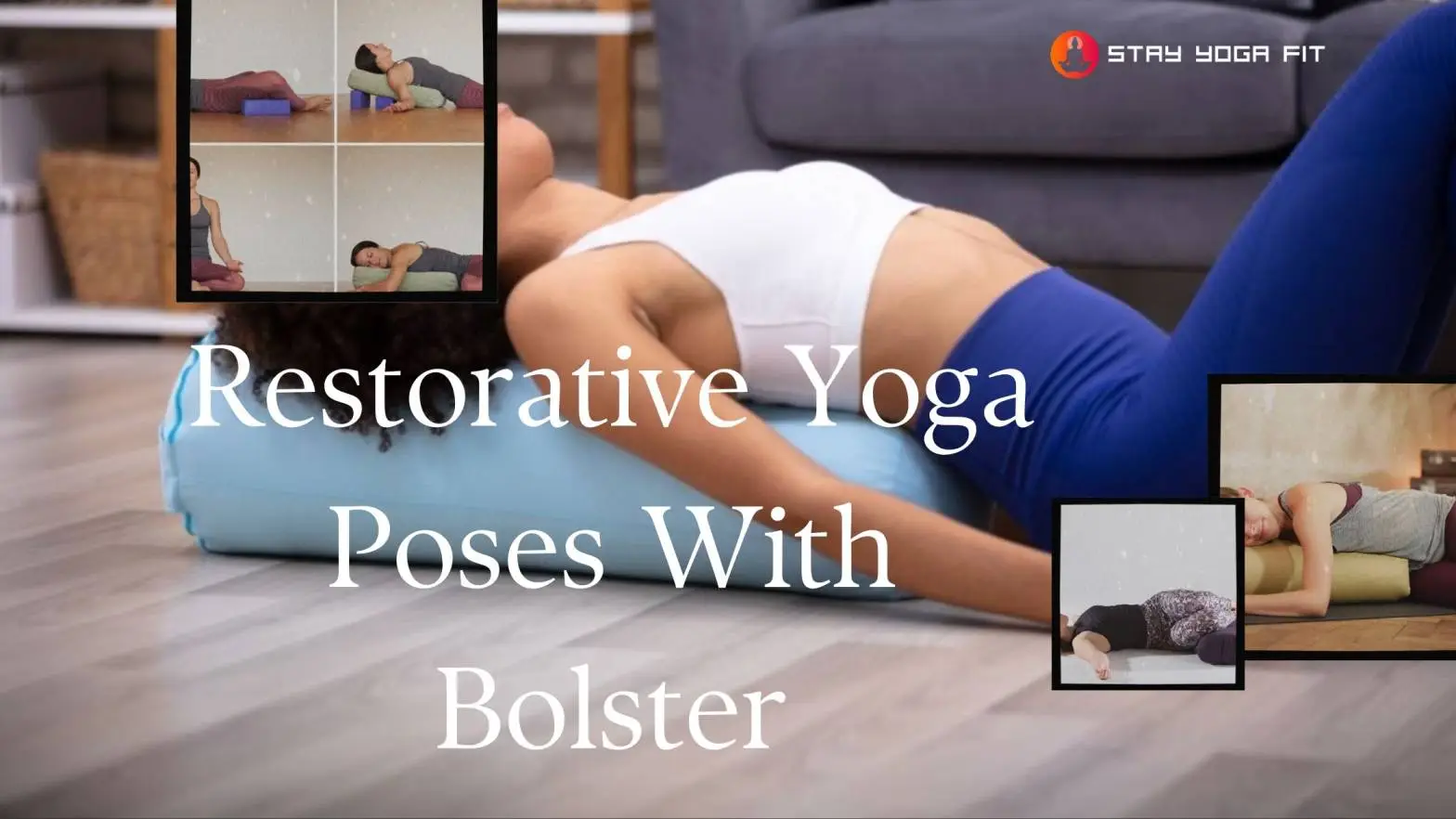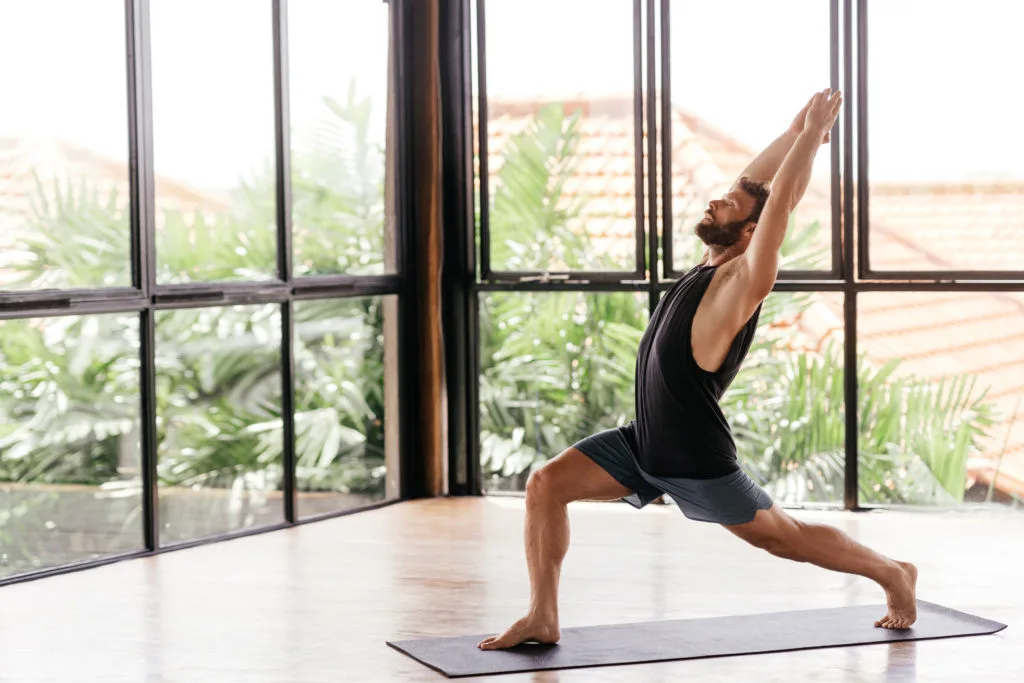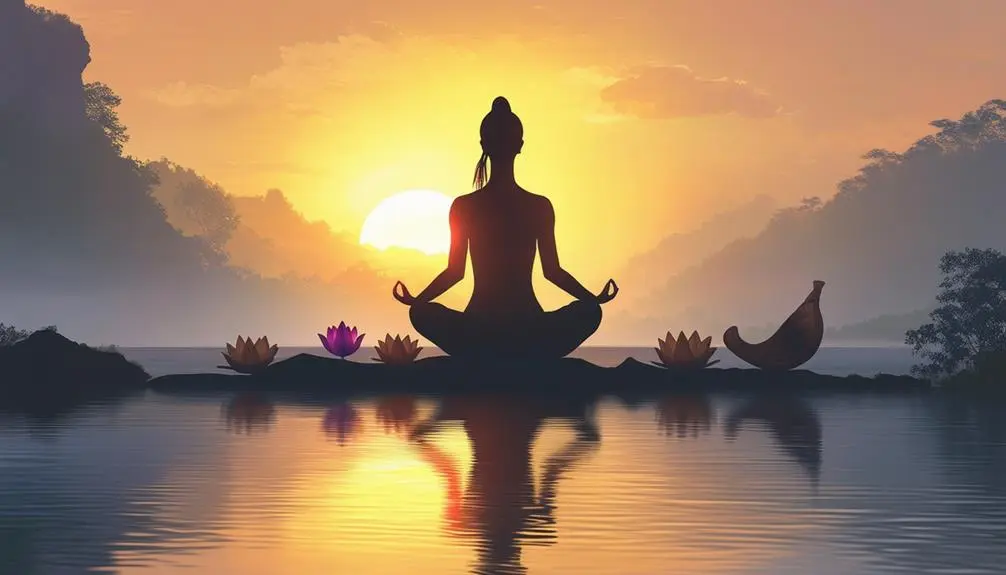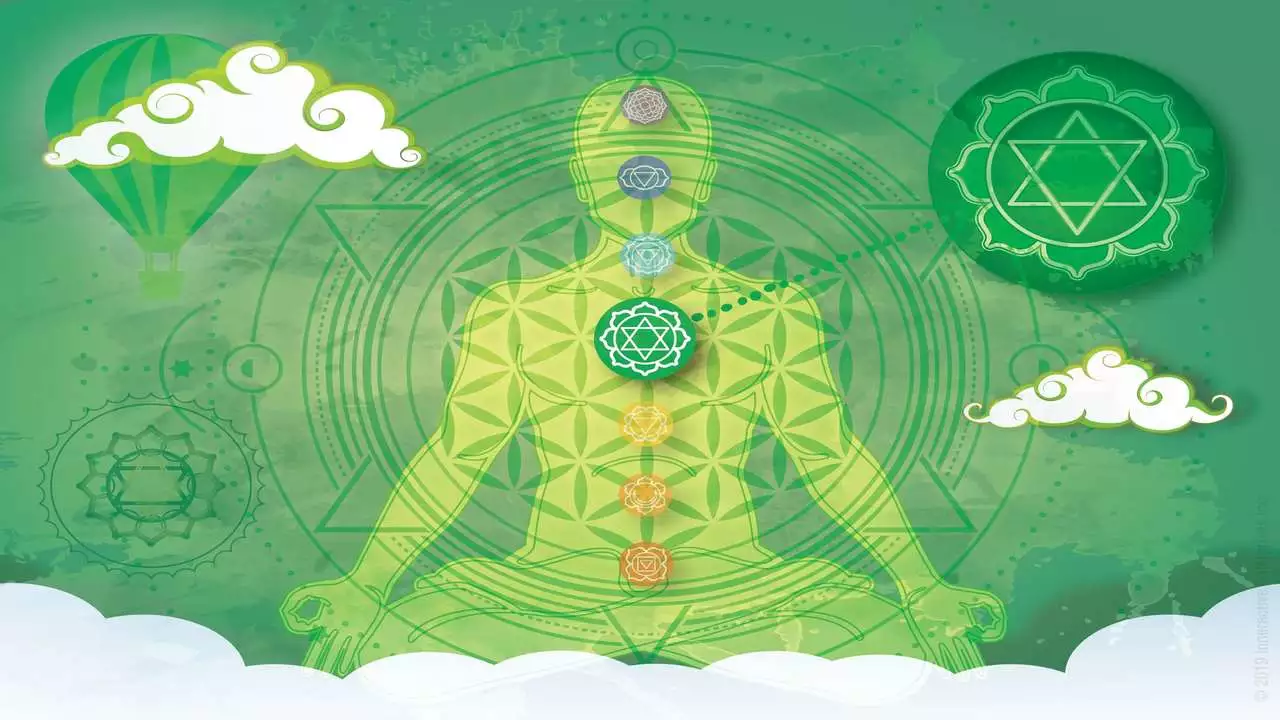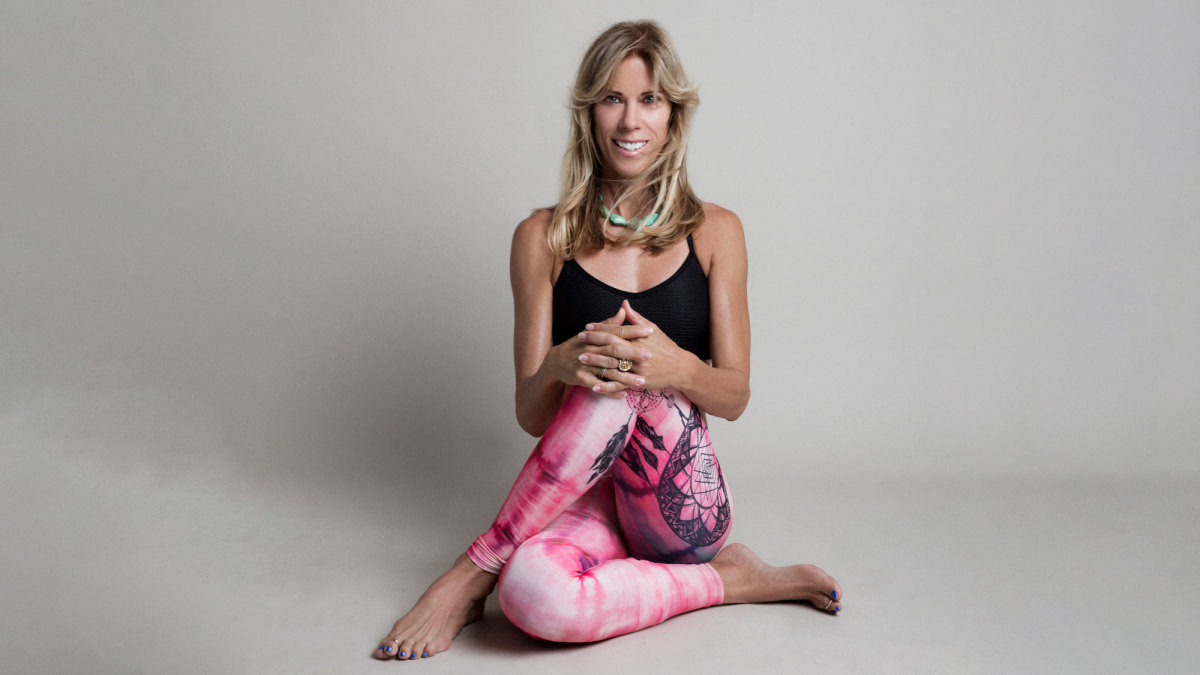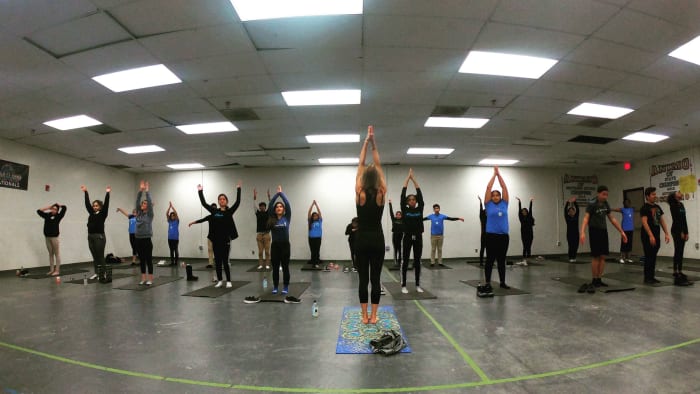Lindsay Tucker: How did you transition into becoming a yoga teacher?
Kirschen Katz: When I was 34 years old, I was trying to become an actress in Los Angeles, and I had many, many jobs. I have been practicing yoga since 1989. I come from a running background—competitive runner at 12 years old, full athletic scholarship. I just always ran, and really was not competing anymore but started to breakdown. So I ended up getting into a yoga practice on my mother's recommendation in 1989. I did my first class with Steve Ross, one of the godfathers of yoga in Los Angeles. I practiced yoga until ’96, and then I was able to take a year off and think about what it is I wanted to do. I decided to become a yoga teacher, and I did teacher training. That's my pre-divorce—I go pre-divorce and post-divorce—pre-divorce was teaching, but I was in a financial life where I didn't have to really struggle. And then he moved me to Hawaii, and my marriage ended there.
LT: So how did you end up working with actors?
KK: I came back to LA, and I really had to boogie to make a living. I was really lucky to be in the right place and open to abundance—that was my mantra after my marriage crumbled. I had signed a prenup and was left very little money. Anyway, I came back to LA, and I was in my hairdresser's salon, and there was a Hollywood wife there, and she said, “Come and teach me yoga.” Through her I met Jenny Belushi—who was married to Jim Belushi, the actor—and Shannon Motenburg, whose husband ran a management production company. And so then these women (and this is now in 2005), they introduced me to just wonderful women in the entertainment business, and one of them introduced me to Julia Roberts. And then the other one introduced me to Reese Witherspoon.
I never went back to teaching classes. I just settled into the private yoga world. I tapped into this niche of, you know, Hollywood and entertainment people, and it's all referral base, as you can imagine, and it's about keeping people’s secrets, about trust. It's a lot of yoga therapy and just really listening to people. I've incorporated running with some of my clients, so for maybe 30 minutes of the private, we’re walking, running—we're doing more of the therapy session—and then the other 30 minutes is yoga. It's not always that way. A lot of clients just want their yoga, but I have been in so many different situations. I've had the royals from Liechtenstein. I've had royals from Abu Dhabi. But I am also a secret, because I am not really involved in the Los Angeles yoga scene. I know the players in it, but it's like I'm just kind of doing my own thing.
See also 10 Business Secrets to Starting a Successful Yoga Career
LT: You work with the Just Keep Livin Foundation teaching yoga as an after-school program in inner city schools. Is that just straight yoga, or are you involved in other ways?
KK: Last year, they asked me to go in and tell my story. It's a story. I grew up with the Nazi- loving father, and I had to heil Hitler until I was older. I didn't know what it was. I grew up in Upstate New York. My mother was loving, but she had no voice. She had no self-esteem. And the father—I refer to him as “the father” and not my father—he grew up a Hitler youth, and I grew up in a very violent, verbally and physically abusive home.
My inspirational story of transformation is something that I want to share with these students, so I go into the schools and I share it. We practice yoga, we talk about my story, and then we have a gratitude circle. But getting back to growing up, yeah, I changed, a violent verbally abusive traumatic childhood and I got out. Running was something that helped me, and yoga was something that helped me process trauma.
LT: And how has yoga helped you process your trauma?
KK: I process it by being still. PTSD comes from war, but it can come from abuse as well. I had tremendous anxiety. I had dyslexia. Nobody ever took me to a doctor or therapist, so I was always running on Cortisol and my adrenals were blown out. I was running 90 miles a week, highly competitive. My body fat was very low. I developed bulimia. I couldn't stand still long enough to tap into my consciousness. You know what I mean?
Running is helpful to produce serotonin and dopamine, but yoga was what I needed to really slow down and tap into my breath and become quiet. Then I was able to approach [the trauma]. Yoga can bring up all your injuries and also all your mental anguish and trauma.
See also A Yoga Therapist Shares the Truth About Trauma
LT: What’s different when you’re solely a private yoga teacher?
KK: You are in these homes and in these people's lives. I have been fortunate enough to have many of my clients for literally 14 years. I've gone through their children with them. I’ve gone through [their] marriages. I have been to more bar and bat mitzvahs than I can share. You know these people intimately on an infinite level. You’re on their journey with them. But what is really nice for me is there are no distractions. It's one on one. I am solely focused on them. It's more intimate, and I love intimacy. I love having my clients feel vulnerable [in a way] that maybe you can’t in a class. You can really devote this hour to their wellbeing and their healing or their nourishing.
If you have a class of 30, 40, 80 people, you cannot really make anything individual. [With private lessons,] you really make it specific to them, what they are feeling that day. I show up and my clients could be crying, and you have to be flexible. I go there, I open the door, I’m invited in, and within a minute I read my clients and know what they need at that moment. That's a unique thing. I love that. Being vulnerable, and that's what I get. I get people on a path, trying to always improve themselves and grow. You get to share that and see that, see people evolve. Traveling with clients is really wonderful. Eat, Pray, Love, that was a great experience. I mean, really interesting. It was so nice to have Julia take me to India.
LT: Can you share more about that experience?
KK: She had been my client for a while. I got a phone call—I am going home on the freeway from my day—and she goes, “Pull over.” She’s like, “I’ve got this movie. It's Eat, Pray, Love.” I knew the book. I knew the book, and I love Elizabeth Gilbert. I was so happy I was going to have the experience with someone who actually wrote something I love to read. You know?
I left for three months: one month in Rome, one month in India, and the best month in Bali. I left my clients, which was tricky. I left them with support yoga teachers. I took videos of them doing yoga, and I sent them to a local studios.
India and Bali are otherworldly. Bali was a wonderful reward for India. India was very challenging. I have heard people say poverty [there] is astounding, but it's way more than I thought it would be. But I embraced it all, and it ended up being wonderful. And the Bali portion was some of the most fun yoga.
It’s funny—I work with these Oscareen actresses, but you forget who they are because you know them as Laura or Reese or Julia, and that whole other part of them is such a different part. They become so much more interesting when you get to know them aside from all that fame.
LT: Tell us a little bit about your personal practice.
KK: It's literally like 20 to 30 minutes a day, and I fit it in whenever I can. It's really just working on the poses. It changes daily; it changes with my mood, with whatever injury I am trying to avoid. I am not the most flexible person. If you looked at my Instagram, the most bearing pose that I can do, Natarajasana and Crow Pose, is strong. I have to be careful because running is very important to me, and I can't do anything where I blow anything out. I use my body for my career, my business, so I don’t ever try anything too daring. I do a lot of pranayama in my own practice, driving around Los Angeles, always doing pranayama counting. I do a lot of mantra and essential oils. Basically I do the practice similar to what I teach. So it's level 2. I love inversions, so I am constantly upside down. Like before this interview I just went upside down a couple of times to calm myself down. If I go three days without practice, I am hard to be around.
See also 30-Minute Beginner Sequence to Reset Your Perspective on Life
LT: What is the hardest thing about being a yoga teacher?
KK: For me, the only downside is all the damn driving that I do—that's it. I put 25,000 miles a year on my car. I just drive a lot. But I love teaching yoga. I love doing it with my clients, and I don’t think about anything in my life. I'm present, and it's pure, and we are moving, breathing, and our breaths are in sync. I am really fortunate enough to teach yoga to people on a journey toward a beautiful life or enjoying a beautiful life or evolved people. I am grateful I have created this too. There is a deep sense of pride for having created this in a moment of trauma. I just came here wishing abundance not only for me but for everyone around me, and the universe presented me with this opportunity. I took advantage of it. I was very open for that. I believe yoga has really helped me to manifest this life I have.

